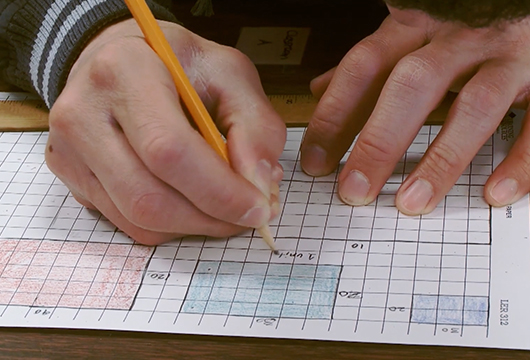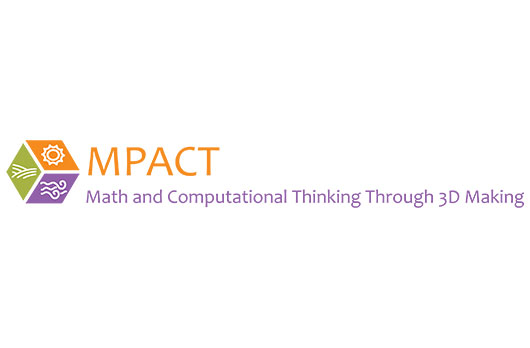TERC Blog
3D Making as a Context for Learning Math, Spatial Reasoning, and Computational Thinking
“I really appreciate MPACT because it has been a really positive, engaging activity that we could be doing with the kids in a crazy, crazy time.”
That’s what one teacher said about the MPACT (Math and Computational Thinking Through 3D Making) projects her students did in the school year 2020-2021, during the coronavirus pandemic. MPACT is a set of materials that structure “making” projects for middle-grades students, developed by TERC mathematics curriculum experts. Making is defined as “a class of activities focused on designing, building, modifying material objects, oriented toward making a ‘product’ of some sort that can be used, interacted with, or demonstrated” (Martin, 2015, p. 31).
MPACT projects get students involved in designing and making a useful or beautiful object, such as a toy for a younger child. These activities serve as grounding for developing understanding of important mathematics topics that span fourth through seventh grade — in addition to spatial reasoning and computational thinking skills closely related to mathematics. For example, students have the opportunity to learn about volume as they model parts of the toy using a computer-aided design (CAD) tool, and then see their design take shape as a real object on the bed of a 3D printer. Then students combine this digital making process with more traditional craft materials, creating a more complete making experience.
MPACT’s Design Conjecture
MPACT developers made a design conjecture that if students work with real 3D prototypes and plans, model them on a 2D digital device screen, and then 3D print the final product, it will provide support for learning math concepts such as volume, spatial reasoning skills such as mental rotation, and computational thinking practices such as making and testing algorithms. Results from an assessment of student learning and reports of teachers’ understanding of the approach provide evidence to support this conjecture. One teacher participating in the study said, “I think the excitement of kids, being able to design something … first on paper and then on a computer and then actually physically hold it — the kids bought into what we were trying to do immediately.”
From Conjecture to Curriculum
In the curricular materials, MPACT supports standards-based mathematics that is embedded in students’ design and making work. For example, in a cube-puzzle project, students complete the following tasks:
- Make the puzzle out of linking cubes.
- Digitally design the puzzle using Tinkercad™, Autodesk’s kid-friendly CAD.
- 3D print the puzzle based on their designs.
- Compare the linking-cube puzzle, the digital design, and the 3D-printed object.
Important basic concepts of measuring volume are developed: A 3D measurement (cm3) can be based on measurements of length (cm). Various methods can be used to find the volume of an object, from organized counting to formulas. Two objects that appear very different can have the same volume. The volume of two or more objects stuck together can be found by adding up the volume of each of them.
In another project, seventh graders modify a board game so that visually impaired and sighted children can play the game together. Students have the opportunity to learn about the mathematical concept of scale as they make game boards from cardstock to fit the game pieces they prototype, design on the computer, and 3D print. Teachers report the project also provides students a chance to further develop empathy for others.

The spatial reasoning that can arise in MPACT projects correlates with success in STEM college classes and careers (Wai, Lubinski & Benbow, 2009). One project that emphasizes spatial reasoning allows students to design a simple stamp of their name in Tinkercad™, including a base and raised letters that can be colored with ink.
After this first step, students should notice that the stamped names are printing backwards, so they can revise their approach. They can draw their designs on paper, creating a reflection of the letters they want on the stamp.
Finally, students test their 3D-printed stamps to check whether the reflected letters make “correct” prints (Figure 2). If not, students may continue to revise their designs until they get the desired text. Once the making process is complete, students are presented with paper-and-pencil brain-teasers, similar to those found on STEM aptitude tests, which allow them to try out their new skills.

MPACT projects provide opportunities to learn computational thinking (CT) as well. While CT was once found mostly in computer science courses, MPACT is among recent efforts to integrate CT into math classes. Each time students digitally model a 3D object, they have opportunity to engage in algorithmic thinking, a key CT practice. They must decide the best order for placing 3D objects on the screen and what functions to use to create a more complex shape with irregular surfaces. By recording that process so others can duplicate it and get the same results, students can verify that they have made an effective algorithm.
As part of the program, students also interact with professionals who design using a CAD and a 3D printer. In a series of interactive video conferences sponsored by the international chemical company Henkel, engineers and others shared their excitement over the new uses and advancements in this rapidly evolving technology. Students learned how 3D printing can build prosthetics for penguins and that it is used in everything from agriculture to aerospace to housing for the homeless.
Results
As part of a two-year evaluation study conducted by SRI International, more than 50 teachers in four states (CA, NC, SC, WV) are teaching with MPACT projects.
The feedback from teachers at the end of the first year of the evaluation, 2020-2021, was quite positive overall. According to one participant, “These are the type of activities that our students crave. They love to dive in and start manipulating and putting math into something real. They love this stuff.”
SRI also reports that students using MPACT units showed statistically significant gains in learning geometry, computational thinking, and spatial reasoning. They developed assessments for fourth and fifth graders to measure students’ learning and administered it in classrooms in fall 2020 and spring 2021. On average, MPACT students improved from pre- to post-test by an effect size of 0.62, roughly equal to a ten percentage-point higher score on the post-test (i.e., a letter grade difference). Results are presented in the graph (Figure 3), which displays the average student score at pre-and post-test, adjusted for grade level.

Next Steps
Once the evaluation of MPACT is complete, the projects will be available to all teachers nationwide at no cost. The program is currently funded by the U.S. Department of Education, through its Education Innovation and Research competition.
Learn more at https://www.terc.edu/mpact3d/
Acknowledgements
MPACT is supported by the Office of Elementary and Secondary Education (OESE), U.S. Department of Education, through Grant U411C180070 to SRI International. The federal grant provides $3,926,461, or 90% of the total project funds. Ten percent of project funds are provided by additional donors. The opinions expressed are those of the authors and do not necessarily represent the official views of, nor an endorsement, by OESE, the U.S. Department of Education, or our other donors.
Author
Jennifer Knudsen is a mathematics educator at TERC whose work is at the crossroads of research and design. A veteran curriculum and professional development designer, Knudsen has led many projects, from mathematical argumentation to 3D modeling and printing for learning mathematics and computational thinking.
References
Charles, R. I., (2005). Big ideas and understandings as the foundation for elementary and middle school mathematics. Journal of Mathematics Education, 7(3), 9-24.
Wai, J., Lubinski, D., & Benbow, C. P. (2009). Spatial ability for STEM domains: Aligning over 50 years of cumulative psychological knowledge solidifies its importance. Journal of Educational Psychology, 101(4), 817.
Martin, L. (2015). The promise of the maker movement for education. Journal of Pre-College Engineering Education Research (J-PEER), 5(1), 4.













